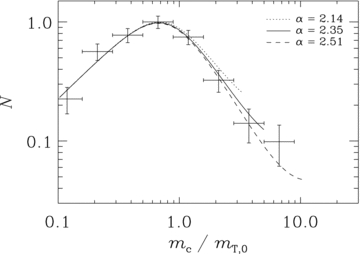| EPoS Contribution |
|
The Initial Core Mass Function Due to Ambipolar Diffusion in Molecular Clouds
Matthew W. Kunz University of Oxford, Oxford, UK | |
| The striking similarity of the initial stellar mass function (IMF) and the initial core mass function (CMF), as revealed by recent submillimeter observations, suggests that the early fragmentation process may play an important role in determining the stellar mass spectrum. Motivated by recent numerical simulations of fragmentation in weakly-ionized, isothermal, magnetic molecular clouds, we have developed a relatively simple analytical prescription for the CMF due to ambipolar-diffusion--initiation fragmentation. The resulting CMF is very similar to the IMF and is in excellent agreement with existing observations. This agreement is robust provided that the three (input) free parameters remain within their range of values suggested by observations. Moreover, there are several features of the predicted CMF that uniquely distinguish it from other theoretical models for the CMF/IMF: (i) the predicted CMF has a lognormal-like shape, despite the fact that no lognormal density distribution was used as input; (ii) there is a definite mass turnover at a unique (dimensionless) core mass, independent of the input free parameters; (iii) the spectrum of core masses is due to natural variations in the local initial mass-to-flux ratio throughout a molecular cloud complex; (iv) all cores are assumed to have formed from magnetically-critical or -subcritical conditions; (v) there is a correlation between the high-mass slope and the maximum (dimensionless) core mass, mediated by the ionization-equilibrium parameter (which is proportional to the product of the degree of ionization and the square root of the neutral number density); (vi) the decay of turbulence due to ambipolar diffusion, rather than the presence of turbulence, plays a crucial role in allowing fragmentation to occur; (vii) self-gravity, magnetic fields, and ambipolar diffusion all play important and collaborative roles in determining the CMF. | |
 | |
| Caption: Initial core mass function predicted by the theory of ambipolar-diffusion--initiated fragmentation. The different lines correspond to different values of n_i/sqrt(n_n), where n_i (n_n) is the ion (neutral) number density: 1.35 x 10^{-5} (dashed line), 9.49 x 10^{-6} (solid line), and 6.70 x 10^{-6} (dotted line). The corresponding power-law exponents from a least-squares fit to the high-mass end of the predicted CMFs are given (for reference, alpha = 2.35 is the Salpeter slope). Larger values of n_i/n_n^{1/2} imply a stronger degree of coupling to the magnetic field, which results in both a steeper high-mass end and a larger maximum (dimensionless) core mass. For comparison with observations, data points from Nutter & Ward-Thompson (2007) are also shown and refer to starless cores in Orion. The excellent agreement between theory and observations is evident. | |
| Collaborators: T.Ch. Mouschovias, UIUC, USA |
Key publication
Suggested Session: Cores and Collapse, Magnetic Fields |

